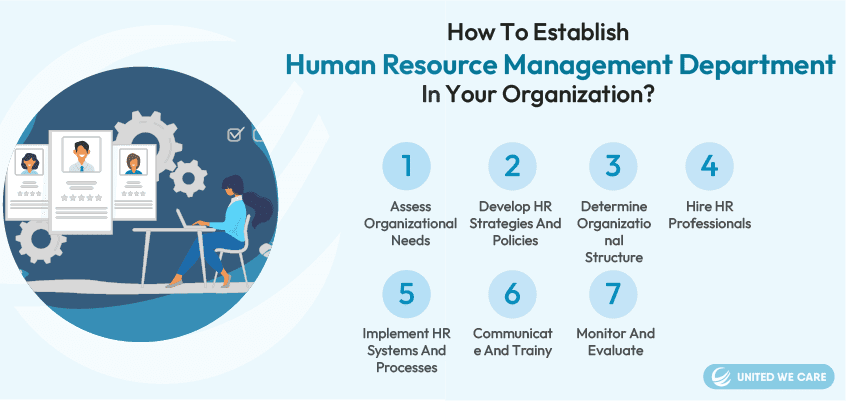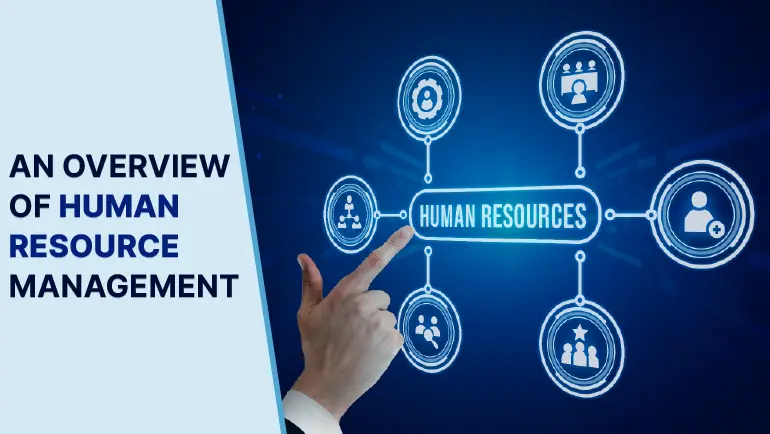Introduction
Who do you meet first when you go for a job interview at a new company? The Human Resource person, right? But do you know what their exact role is? Human resource management (HRM) is a department in an organization that is responsible for managing and developing people and policies. When we think about HRM, we usually think that it’s about hiring suitable people for a particular job profile. But, in reality, HRM is a much larger concept. Other than recruiting, HRM takes care of training, developing company policies, and employee relations.
“I am convinced that nothing we do is more important than hiring and developing people. At the end of the day, you bet on people, not on strategies.” -Lawrence Bossidy. [1]
What Is Human Resource Management?
The term ‘Human Resources’ was coined in 1911 by an American engineer named Frederick Winslow Taylor. Human Resource Management (HRM) is the department that takes care of the employees in an organization. The reason why it’s called ‘Human Resource Management’ is simply because, without human beings, no organization can grow leaps and bounds. So the real resources or valuable entities in an organization are its employees.
HRM involves hiring the best people suitable for a particular job, training them with the skills needed for the role, and making sure that they stay for a long time. HRM also takes care of employees’ salaries and bonuses. They also provide solutions to any issues that the employees might be facing, along with holding activities that involve the entire organization so that they get to know each other and that a positive environment is created.
Remember Toby from ‘The Office’? When I watched the show as an adolescent, I felt that HR managers, or HRs, had the most boring jobs ever and that they barely did anything even though they seemed busy all the time. But, when I started understanding the field more, I started realizing that HRM is the foundation of an organization. They have to address so many different areas in the organization that the workload can sometimes overwhelm them. From training to technological issues to globalization, we depend on HRs to handle it all [2].
What Is The Importance Of Human Resource Management?
Human Resource Management (HRM) plays a crucial role in organizations, and its importance is visible in many areas [3]:
- Talent Acquisition and Retention: The first person we meet at any organization is someone from the HRM department. HRs send out messages saying that they are hiring new people for the organization. They also have to make sure that the company is able to retain employees who help in the success of the business. When the HR is effective in doing these tasks, employees are happier and show better results at work, leading to the overall growth of the organization.
- Employee Development and Engagement: One of the major responsibilities of the HRM is to provide the right training to each employee. In one of my previous organizations, during the process of training, I learned so much about the company and my role that my work became smoother. In addition to that, they taught us some more tricks and tools that I use to date. Such opportunities help develop a career beyond the initial skill set. After such training, I was highly motivated and satisfied with the work I was doing.
- Performance Management: The reason why we know what our job role is in any organization is because the HRM designs the job descriptions and sets expectations clearly. In fact, they also provide appropriate feedback and appreciate hard work and high performance. Doing so can improve the performance of the team and the individual employees and help the organization grow.
- Employee Relations and Well-being: HRM ensures that all employees are working in harmony with each other, and if there are any issues, they strive to resolve all issues and create a healthy and positive environment at work. When employees are happy and stress-free, they produce more results, and the company automatically grows.
- Strategic Alignment: HRM designs strategies and policies to meet the goals of the company. When policies and strategies are in place, work becomes smoother and more streamlined. I once worked at a start-up that did not have anything in place for good two years, and many people got recruited, but they soon left as no strategies meant that their work was not getting managed well or appreciated. Two years later, the company shut down its operations.
- Legal Compliance: The labour laws of every country help to protect employees. HR has to guarantee that the rules and policies of the company work according to the laws of the country. The company cannot demand 20 hours of work every day because that will lead to burnout and increase stress levels and other health issues. If any company goes against the laws, then an employee can take legal action, and the HRM will be answerable.
What Are The Stages Of Human Resource Management?
HRM is a step-by-step process, which includes [4]:
Step 1: Planning about the strategies for growth and which all departments require more staff members.
Step 2: Selecting and hiring the people who rightly fit in the company.
Step 3: Training the hired staff on the workings of the organization and their roles.
Step 4: Conduct regular checks to ensure that employees are fulfilling their roles properly.
Step 5: Designing the salary structures and making sure that the employees are paid their dues timely.
Step 6: Check if any employees have any management concerns and resolve any conflicts at the earliest.
Step 7: Evaluate data to check if the company requires any new policies or if there are any improvement areas.
This step-by-step process can make an organization grow exponentially, with happier employees and a healthy work environment.
How To Establish A Human Resource Management Department In Your Organization?
HRM is the most important department in any organization. So, establishing one needs to be strategized and implemented properly [5]:

- Assess Organizational Needs: Do a thorough analysis of the gaps and challenges you are facing in the organization. Once done, create opportunities according to how you would want your company to function and check what you need the HR department for exactly, currently and in the future.
- Develop HR Strategies and Policies: When you start your company, I’m sure you know what goals you have in mind. According to those goals, work out what strategies and policies the HRM should follow. Probably you can do your research on some of the best practices in the industry in terms of recruitment, training, salaries, etc.
- Determine Organizational Structure: You can create a structure of the organization and how the hierarchy in the organization should look, depending on the size of the company. For example, there can be a Vice President of HRM under whom there can be various people handling different HR roles.
- Hire HR Professionals: The next thing would be to actually hire the right candidates as HRs in the company. Before you do that, remember to look into the degrees and skills needed in the employees.
- Implement HR Systems and Processes: When you create a proper HR system and process, all employees in the organization would know who to report to, what their job roles are, and how they can improve the functioning of the company. Also, time-to-time, HRs can conduct performance reviews using the standards established by you.
- Communicate and Train: When your company is new, but there are already some employees working, make sure to tell them that you are starting the HRM department. Maybe you can conduct training on what the HRM role is and what would some of the policies that you would want to introduce in your company. That way, all employees will be on the same page.
- Monitor and Evaluate: The way the HRM department checks the performance of the employees, you can also check up on the HRM department to make sure that they, too, are following the processes well and that there are no conflicts and issues in that department.
Conclusion
Human Resource Management (HRM) is one of the most important departments in any company. They are the glue that holds the employees together, whether it is through activities or through policies. HRM can play a crucial role in creating a positive work environment. Their responsibilities can be endless; however, it is the role of the management to make sure that they are well taken care of and that they don’t burn out. A happy HRM means a happy organization.
If you are part of an organization looking for programs to maximize employee potential, create a positive work environment, and support the holistic well-being of your employees, connect with us at United We Care!
References
[1] N. M, “You Bet On People, Not On Strategies | Entrepreneur,” Entrepreneur, Jul. 19, 2016. https://www.entrepreneur.com/en-in/leadership/you-bet-on-people-not-on-strategies/279251
[2] P. B. Beaumont, Human Resource Management: Key Concepts and Skills. 1993.
[3] J. H. Marler and S. L. Fisher, “An evidence-based review of e-HRM and strategic human resource management,” Human Resource Management Review, vol. 23, no. 1, pp. 18–36, Mar. 2013, doi: 10.1016/j.hrmr.2012.06.002.
[4] H. D. Aslam, M. Aslam, N. Ali, and B. Habib, “Importance of Human Resource Management in 21st Century: A Theoretical Perspective,” International Journal of Human Resource Studies, vol. 3, no. 3, p. 87, Aug. 2014, doi: 10.5296/ijhrs.v3i3.6255.
[5] R. A. Noe, B. Gerhart, J. Hollenbeck, and P. Wright, Fundamentals of Human Resource Management. Irwin Professional Publishing, 2013.





